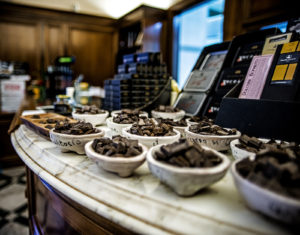A visit to Modica means a visit to its churches, walks along Via Umberto and tasting
chocolate
.
 Cocoa has very ancient and not very Sicilian origins. The first people to work the seeds were the Aztecs in distant Central America. It was later in the 16th century that the Spaniards brought the tasty seeds to the
County of Modica
Cocoa has very ancient and not very Sicilian origins. The first people to work the seeds were the Aztecs in distant Central America. It was later in the 16th century that the Spaniards brought the tasty seeds to the
County of Modica
. What makes Modica’s chocolate unique is its special cold processing, which gives it a grainy and irregular appearance. The first flavours to be added were vanilla and cinnamon, and over the centuries new ones were experimented with. Over the years the techniques were changed and refined, but the master chocolatiers of Modica did not want to modify the original recipe or process in any way.
This means that we can still taste the ancient flavours of an ancient tradition today. In 2003 the city’s twenty producers formed the Modica Chocolate Consortium in the aim of protecting and defining the processing and production techniques.